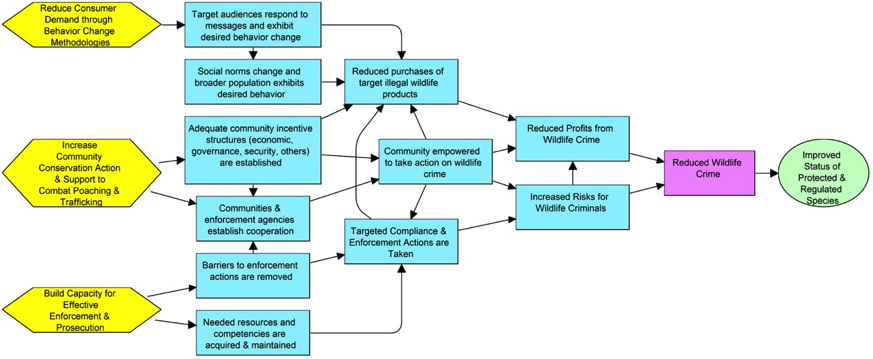
The CWT Learning Group is focused on building a knowledge base around how best to build capacity, reduce consumer demand, and improve community engagement to combat wildlife crime.
Combating Wildlife Trafficking
USAID has a long history of support for efforts to combat wildlife trafficking (CWT). These efforts are currently being prioritized due to a dramatic increase in the volume and scope of the threat in recent years and the February 9th, 2017 Executive Order on enforcing federal law with respect to transnational criminal organizations and preventing international trafficking.
Among the many strategic approaches employed by USAID to combat wildlife trafficking and outlined in the Agency's Measuring Efforts to Combat Wildlife Crime Toolkit, USAID’s Forestry and Biodiversity Office chose three for special attention for the CWT Learning Group based on their frequency in USAID programming: (a) reducing consumer demand through behavior change methodologies, (b) building capacity for effective enforcement and prosecution, and (c) increasing community conservation action and support to combat wildlife trafficking. These three strategic approaches are defined by development hypotheses (theories of change), as well as a combined hypothesis that, if implemented, these strategic approaches will increase the risks for wildlife criminals and reduce profits from wildlife trafficking, which will then reduce overall wildlife crime, leading to improved conservation results.
While used across many countries, there is often little supporting information available to practitioners regarding the effectiveness of these approaches or the validity of key assumptions. As USAID begins or ramps up efforts, there is an important opportunity for this Learning Group to support cross-mission collaboration to capitalize on previous experiences, share the latest information, and build the evidence base for these approaches.
WHAT IS THIS WIKI?
This wiki is a shared space where the Collaborative Learning Group can build a knowledge base on combating wildlife trafficking. It is organized around the key questions from the group’s Learning Agenda (more info on this can be found here).
WHAT IS Combating Wildlife Trafficking?
Combating Wildlife Trafficking provides ______________________
HOW CAN I GET INVOLVED?
- Add new content (i.e., new contributions to the knowledge base), or make a comment about the existing content in the comments section
- Discuss or propose changes in the comments
- Share thoughts or ideas with the facilitators
USER GUIDANCE:
Users are encouraged to add new content directly to these wiki pages. Please provide a source for all your additions (including personal experiences, anecdotes, quotations, document references, etc.). Please note your source in parentheses following your added content. For source documents, grey or peer-reviewed, please provide a full citation. Facilitators will convert your source information into endnotes and move them to the reference list. To suggest major revisions or the removal of existing content, please use the comment section. Following group discussion, facilitators will implement agreed-upon changes to the page.

- Teacher: John Folstrom
- Teacher: Megan Hill
- Teacher: Shawn Peabody
- Teacher: Guest Teacher
- Teacher: Ryan Thompson
